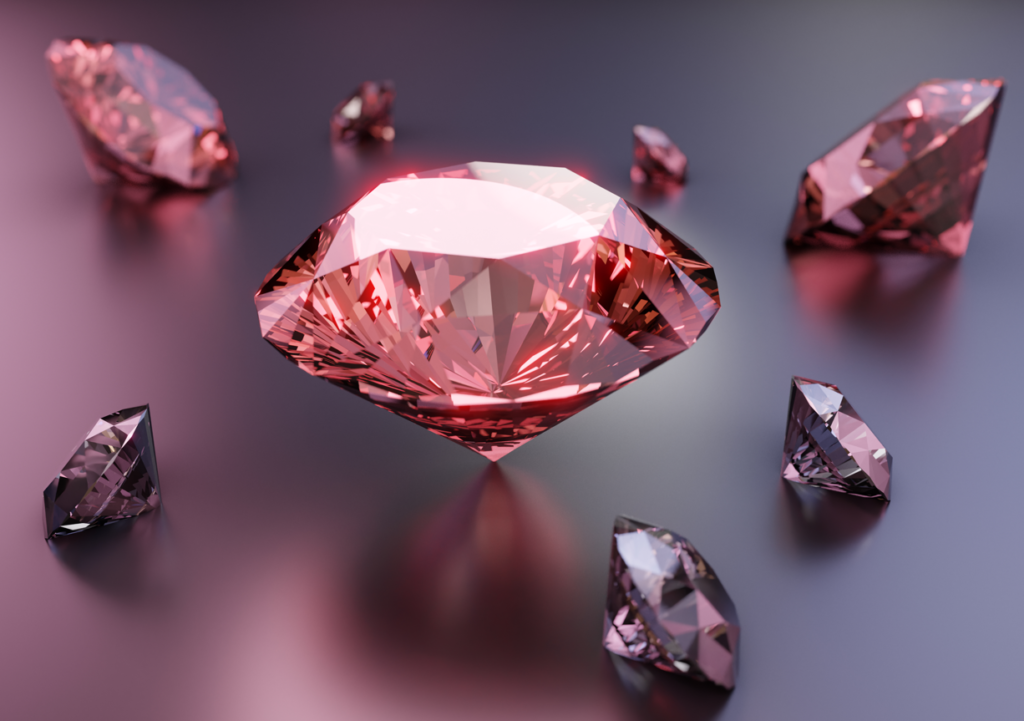Suppose you bought a diamond ring for your engagement. It’s simply lovely, nevertheless it has include the guilt that it will need to have made a larger-than-life gap in your fiancé’s pocket. Loosen up, it might be a lab-grown diamond, which is as bedazzling as a pure however with a lighter price ticket. Clearly, you possibly can’t ask your fiancé about it. Curiosity is consuming you up, however so is the concern of being judged or sounding ungrateful. Loosen up, you might be on the suitable web page; this weblog will information you thru the entire technique of figuring out a diamond’s origin with out feeling awkward or embarrassed.
Diamonds dazzle. However not all sparkle comes from ages underneath Earth’s crust — some equally glowing are born in labs. As a phrase, when used independently, ‘Diamond’ primarily signifies a pure diamond. Phrases like lab-grown, laboratory-grown, artificial, or man-made diamond are specified to authenticate the origin or manufacturing course of. However what if it’s not talked about?
-
Can You Inform With Your Bare Eyes a Laboratory-Grown Diamond From a Pure Diamond?
No. Each look similar to the unaided eye. Advances in expertise have blurred the road a lot that even skilled jewelers often can’t inform with out magnification or devices. That’s why it is advisable to depend on certifications, inscriptions, {and professional} testing.
If you wish to purchase properly (no regrets later), figuring out the distinction is extra than simply trivia — it protects worth, ethics, and belief.
-
How Do I Know Whether or not I’m Buying a Pure or a Laboratory-Grown Diamond?
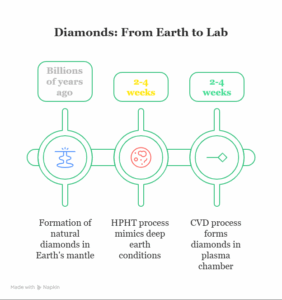
Diamonds might all sparkle the identical to a layperson, however not all are created the identical manner. Some are born deep within the Earth over billions of years, whereas others are grown inside a lab in simply weeks. With lab-grown diamonds usually 40–60% cheaper than mined ones, understanding the distinction is essential to preserving each worth and belief.
Right here’s a transparent, expert-backed information—drawing on insights from the Pure Diamond Council and Grown Diamond Corp—that will help you inform them aside.
1. Test for Certification from Respected Gemological Institutes.
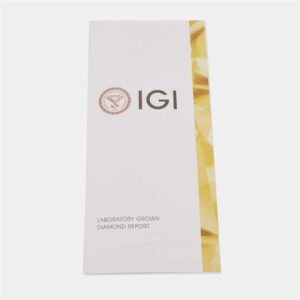
Essentially the most dependable method to decide a diamond’s origin is by way of certification from trusted organizations, such because the Gemological Institute of America (GIA), the Worldwide Gemological Institute (IGI), or SGL Labs. These stories element whether or not a diamond is pure or lab-grown, in addition to different key traits, together with lower, readability, and carat weight.
- What to Look For: GIA and IGI stories explicitly state “Lab-Grown” or “Pure” of their documentation. For lab-grown diamonds, the certificates may additionally point out the expansion technique (HPHT or CVD).
- Why It Issues: Certifications present an unbiased, skilled evaluation, guaranteeing a vendor’s claims don’t mislead you.
Tip: At all times request to see the unique certificates or confirm the report quantity on-line by way of the institute’s database.
2. Examine for Laser Inscriptions Below Magnification
Many diamonds, particularly these licensed by GIA or IGI, function microscopic laser inscriptions on their girdle (the diamond’s periphery). These inscriptions embody the certificates quantity and, for lab-grown diamonds, usually point out their artificial origin.
- What to Look For: Use a jeweler’s loupe (10x magnification) or a microscope to examine the girdle for inscriptions similar to “Lab-Grown,” “LG,” or the certificates quantity. Pure diamonds sometimes solely have the certificates quantity.
- Why It Issues: Laser inscriptions supply a fast and non-invasive technique for verifying a diamond’s authenticity, notably when mixed with a corresponding certificates.
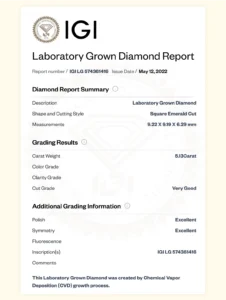
- What the Pure Diamond Council (NDC) says: Authorized definitions and promoting tips mandate that lab-grown diamonds have to be clearly disclosed as such. Certification stories should state whether or not the stone is pure or lab-grown, and if lab-grown, the precise course of used (CVD or HPHT) have to be specified.
Tip: At all times ask to see the grading report. If the report doesn’t explicitly say “pure,” assume lab-grown or undisclosed. Labels like “diamond” with out qualifiers are likely to indicate pure diamonds legally.
3. Study Inclusions and Development Patterns.
Whereas each lab-grown and pure diamonds might have inclusions (inside flaws), their progress patterns differ because of the distinct formation processes concerned of their creation. Pure Diamonds kind over tens of millions of years underneath the acute situations of Earth, whereas lab-grown diamonds are created in weeks underneath managed environments.
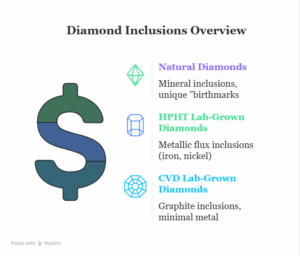
- Pure diamonds: Fashioned over tens of millions to billions of years deep in Earth’s mantle. Their progress patterns (grain, crystal construction) are advanced, usually irregular, with inclusions like minerals, feathers, or tiny “nature marks.”
- Lab-grown diamonds, Particularly These Grown Utilizing CVD or HPHT strategies, exhibit distinct progress buildings. As an illustration, progress striations, metallic inclusions, or clearer, extra uniform options. Below magnification + with specialised instruments, these patterns are distinguishable.
- The NDC report notes that as a result of crystals develop in another way in pure environments versus laboratory environments, their grain or structural patterns differ, {and professional} devices make the most of this to tell apart them.
Tip: These variations, although delicate, will be recognized by a skilled gemologist utilizing a microscope.
4. Use Specialised Testing Strategies.
Based on the NDC, all lab-grown diamonds will be recognized by professionals with the suitable tools. Superior testing strategies, sometimes performed by gemological laboratories or expert jewelers, can definitively distinguish between lab-grown and pure diamonds. These checks analyze properties that differ because of the diamonds’ formation environments.
Spectroscopic & Fluorescence Instruments
- Fluorescence underneath UV mild: Pure diamonds usually comprise nitrogen impurities, which have an effect on their fluorescence. Lab-grown diamonds are likely to have very low nitrogen or different impurity profiles; their fluorescence response will be extra uniform or completely different underneath UV or short-wave mild.
- Spectroscopy & impurity evaluation: Professionals use devices that may detect hint components, measure composition, and interpret spectral fingerprints. These embody checking nitrogen content material and the way the diamond responds to UV or infrared mild.
- Fourier-Rework Infrared (FTIR) or Raman spectroscopy can detect delicate variations within the diamond’s molecular construction, figuring out markers particular to the expansion technique.
- Based on the Pure Diamond Council’s information, lab-grown diamonds produced by way of colorless processes usually take away practically all nitrogen, which is a standard impurity (~99%) in pure diamonds. This results in completely different habits underneath UV / spectral evaluation.
Electrical Conductivity: Some lab-grown diamonds (particularly HPHT) conduct electrical energy as a result of hint components, whereas most pure diamonds don’t.
Tip: These checks present scientific precision, leaving no room for doubt a few diamond’s origin.
5. Search a Skilled Appraisal
When doubtful, a trusted jeweler or licensed gemologist can present an knowledgeable appraisal. They mix visible inspection, certification verification, and superior testing to verify a diamond’s origin.
- Why It Issues: Knowledgeable’s experience ensures accuracy, particularly for high-value purchases, the place misidentification might lead to vital monetary loss.
- The right way to Select: Choose a jeweler with credentials from organizations just like the American Gem Society (AGS) or one who makes use of GIA/IGI requirements.
- Extra safeguards: Make the most of ASSURE program instruments, which the NDC oversees, for efficiency testing of verification devices. Make sure the jeweller or lab makes use of devices which were validated underneath such applications.
Tip: Keep away from value determinations from sellers with a vested curiosity within the sale, as they could lack impartiality.
FAQs: Frequent Questions About Figuring out Lab-Grown vs. Pure Diamonds.
Why It’s Changing into More durable to Inform Lab-Grown from Pure Diamonds?
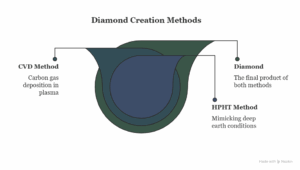
Lab-grown diamonds, created utilizing Excessive-Strain Excessive-Temperature (HPHT) or Chemical Vapor Deposition (CVD) strategies, share the identical chemical and bodily properties as pure diamonds. Each are composed of carbon atoms in a crystal lattice, making them visually and structurally related. Fashionable manufacturing methods have refined lab-grown diamonds to carefully mimic pure ones carefully, usually requiring specialised instruments or experience to tell apart them from pure ones. This similarity, mixed with their decrease value (often 30-50% lower than pure diamonds), has made correct identification important for patrons looking for transparency.
What Instruments Are Used to Detect Artificial and Pure Diamonds?
Specialised devices are required. Examples embody:
- DiamondView/De Beers testers reveal fluorescence and progress patterns.
- Spectroscopic analyzers measure impurities, similar to nitrogen content material.
- ASSURE-tested verification gadgets – licensed instruments for dependable identification.
Collectively, these instruments make detection near 100% correct.
How do I do know whether or not I’m buying a pure or a laboratory-grown diamond?
To make sure you’re buying the meant sort of diamond, all the time request a certification from a good gemological institute, similar to GIA or IGI, which clearly states whether or not the diamond is pure or lab-grown. Moreover, examine for laser inscriptions on the diamond’s girdle. Seek the advice of knowledgeable gemologist for an appraisal or request superior testing (e.g., spectroscopy) if no certificates is out there. Verifying these particulars with a trusted, impartial supply is vital to avoiding misrepresentation.
Are you able to examine if a diamond is lab-grown at house?
Whereas fundamental checks, similar to utilizing a jeweler’s loupe to examine inscriptions or inclusions, will be carried out at house, definitive identification usually requires skilled instruments, together with spectroscopy or UV testing. For correct outcomes, seek the advice of a gemologist.
Do lab-grown diamonds check as “actual” on a diamond tester?
Let’s make one factor clear- lab-grown diamon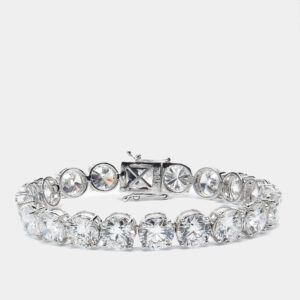 ds are very much real, albeit not pure. Sure, lab-grown diamonds check as pure on normal diamond testers as a result of they’ve the identical chemical composition (carbon) as pure diamonds. Testers distinguish diamonds from simulants, similar to moissanite, however not lab-grown diamonds from pure ones.
ds are very much real, albeit not pure. Sure, lab-grown diamonds check as pure on normal diamond testers as a result of they’ve the identical chemical composition (carbon) as pure diamonds. Testers distinguish diamonds from simulants, similar to moissanite, however not lab-grown diamonds from pure ones.
The right way to Purchase Good and Keep away from Confusion: Select The Luxurious Closet.
Distinguishing between lab-grown and pure diamonds primarily depends upon certification, inspection, and knowledgeable verification. At all times examine for a GIA or IGI certificates, search for laser inscriptions, and search skilled value determinations for high-value items. Whereas lab-grown diamonds supply affordability and moral attraction, pure diamonds stay prized for his or her rarity and heritage. The hot button is shopping for with confidence and transparency.
That’s why The Luxurious Closet brings you The Diamond Edit—an unique assortment of GIA-certified lab-grown diamond jewelry. Curated for readability, high quality, and authenticity, it’s your trusted vacation spot for diamonds that dazzle and are but inexpensive no doubt.
The put up 5 Ways to Identify a Lab-Grown Diamond from a Natural One. appeared first on Inside The Closet.
